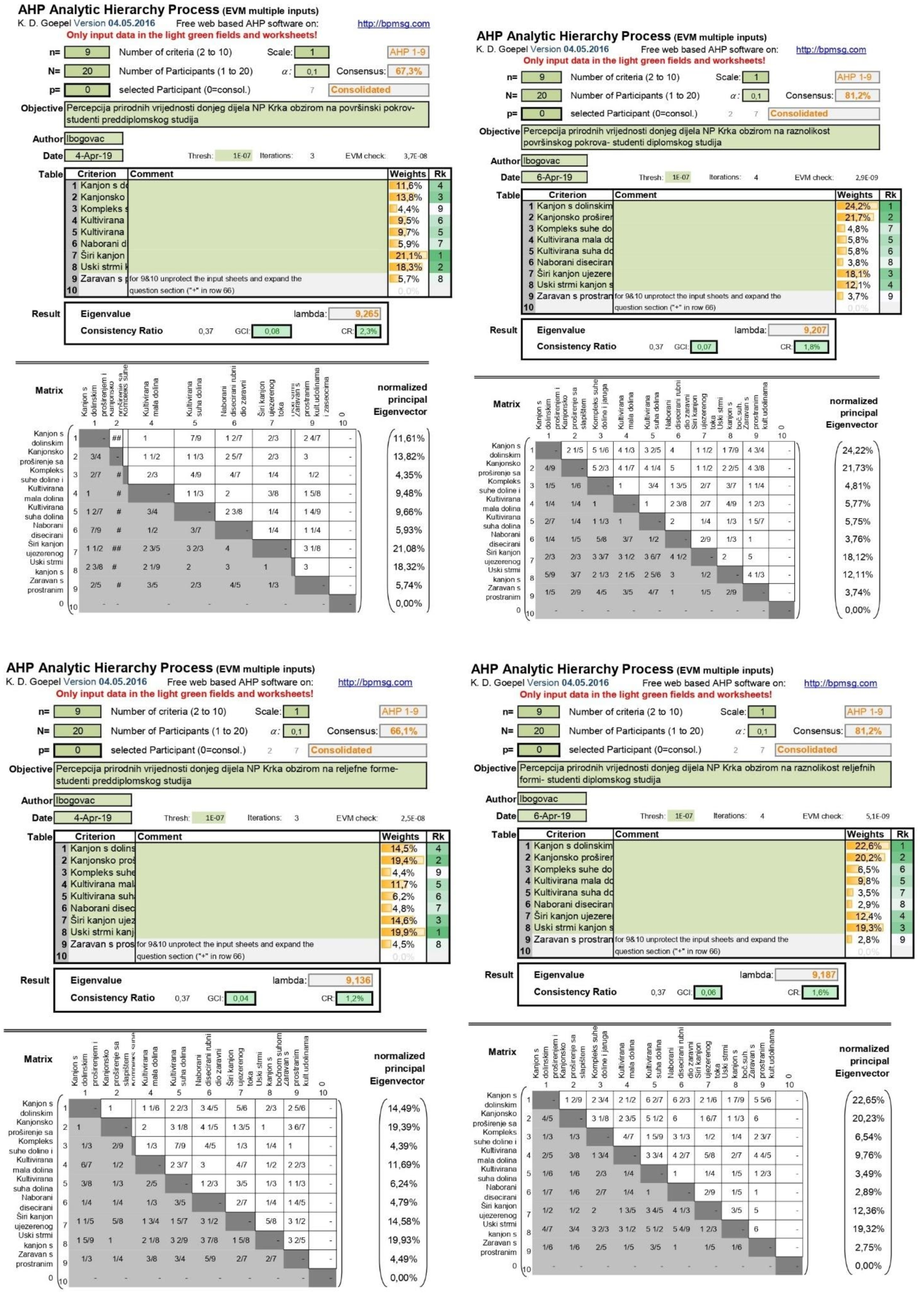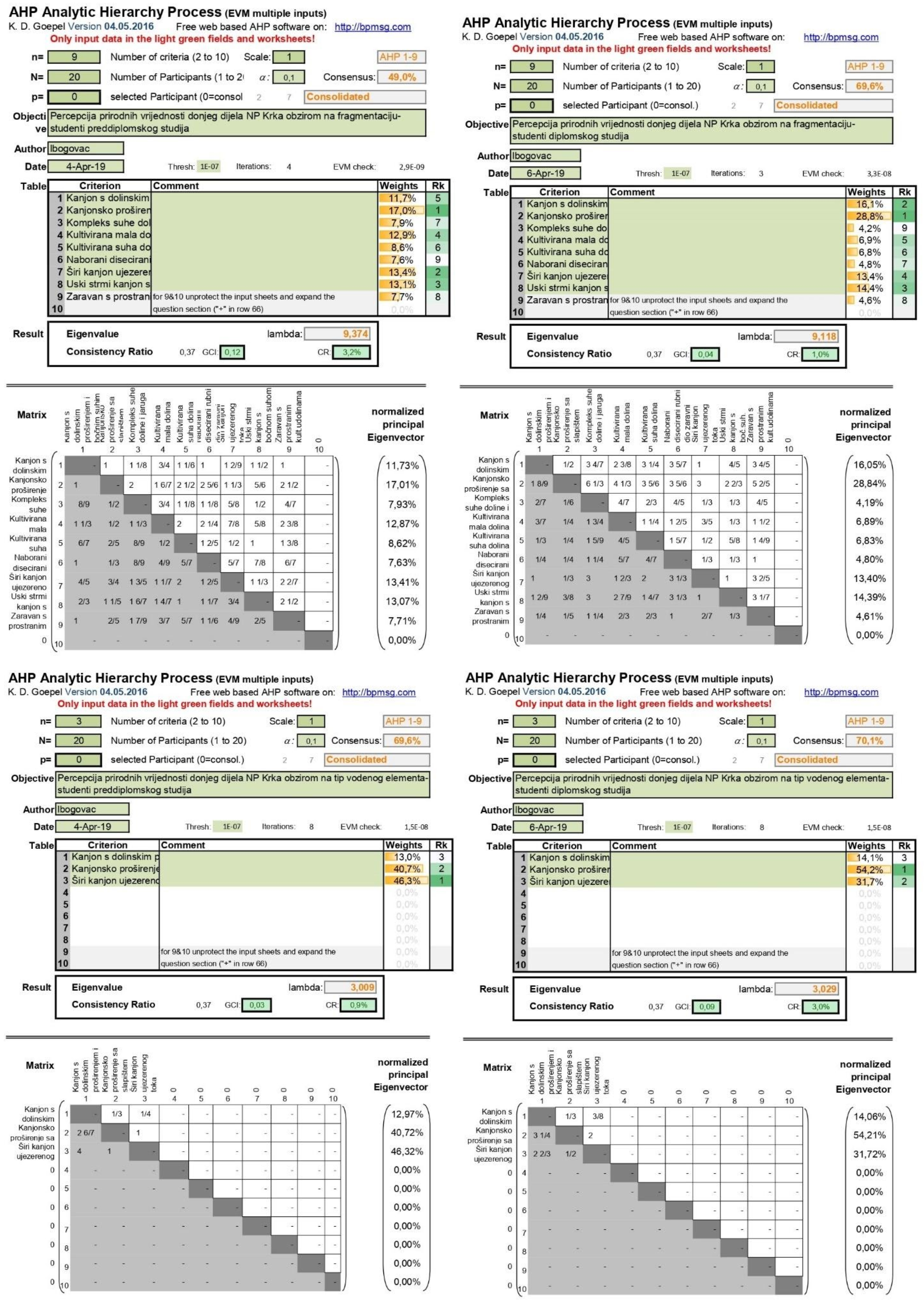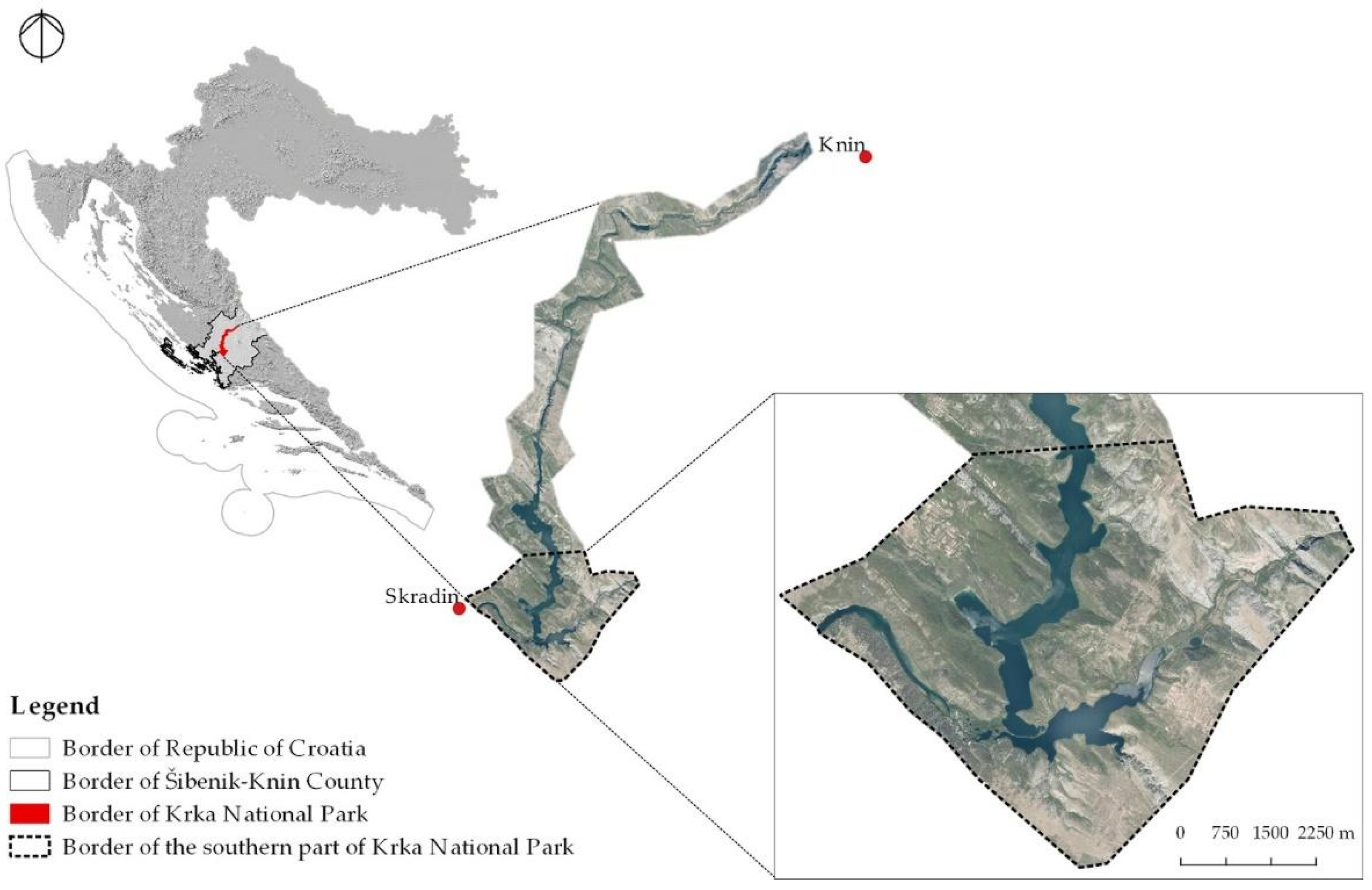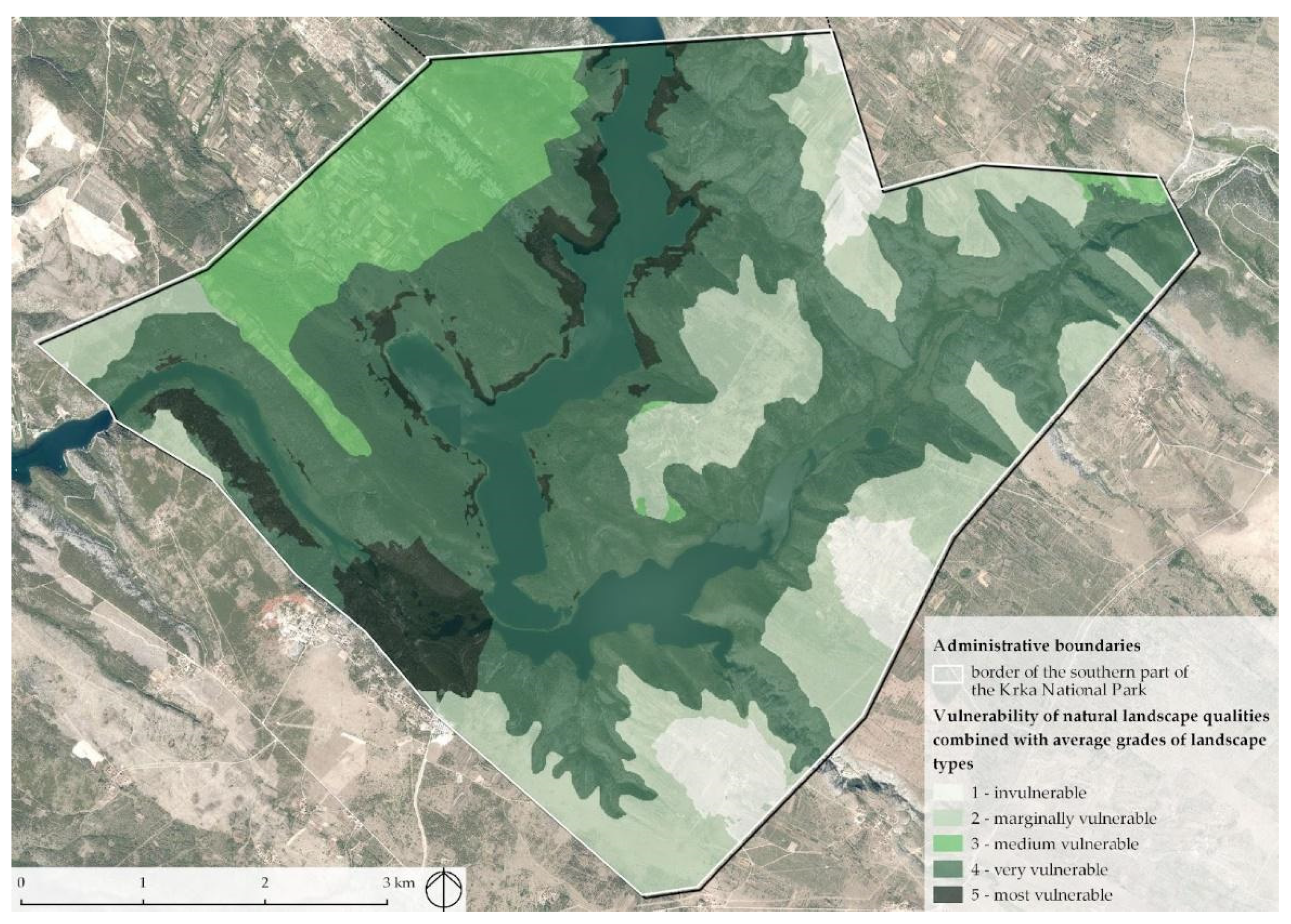3.1. Research Area
According to the current Management Plan [
35], Krka National Park covers most of the Krka River (75 km south of Knin all the way to Skradin) and its canyon. Parts of the Krka River were first protected in 1948, and gained legal status as a national park in 1985. The protection is based on geomorphological, hydrological, and landscape values, and consists of canyons, waterfalls, rapids, lakes, and travertine barriers as a fundamental phenomenon. Other values have been recorded, such as the originality of the animal and plant world, speleological objects, as well as the rich cultural heritage in the form of ethnological, archaeological and industrial heritage [
35]. The entire Krka National Park is also protected as an area important for the conservation of endangered species and habitat types of the EU in the ecological network Natura 2000 of Croatia.
The selected area of the Krka National Park (
Figure 1) includes the southern part of the Krka River Canyon (from Visovac Lake to the mouth of the Čikola River in Krka), the Čikola River Canyon from Gradina to the mouth, part of the Miljevci Plateau, North Dalmatian Plateau and Ravni Kotari. Therefore, it represents a diverse set of natural and cultural values of this part of Croatia. At the same time, this part of the National Park has very high landscape diversity and therefore was selected for this research. There are numerous significant natural sites here, but the most important are tufa barriers and Skradinski buk at the mouth of the Čikola River.
Landscape Characteristics
In the LCA, which was an integral part of the Krka National Park LCA study [
5], multi-level landscape units were mapped, which Brunetta and Voghera [
12] describe as parts of the area that have equal morphological, ecological, cultural (social and economic) characteristics. More specifically, landscape units consist of a specific combination of relief, geology, soil types, vegetation, land use patterns, and spatial patterns of fields and settlements (
Figure 2).
Firstly, landscape types were identified. They are generic in a way that they can occur in different areas of the research area, and they always share a similar combination of factors. This is followed by the identification of landscape areas as unique and concrete geographical areas of a certain landscape type of unique character and identity, and whose distinction is determined by naming the landscape type through the corresponding geographical name or toponym.
The term landscape type has a generic meaning therefore landscape character type can occur in different areas of the territory, yet they share a similar combination of landscape elements. According to the corresponding landscape areas of the wider regional level (North Dalmatian plateau, Ravni kotari, and Krka and Čikola canyons) (
Figure 3), landscape types of the Krka National Park area were generally classified (
Figure 4).
Within the landscape evaluation process, landscape character is defined as a specific combination of natural and cultural factors of landscape formation. Certain landscapes are different due to their inherent, distinctive and consistent pattern of elements. Landscape character assessment starts by mapping landscape units that can be implemented on multiple levels and scales [
4], and they represent unique spaces with the same landscape character at a specific location. Field studies are methods to identify landscape elements and their characteristics that in unique combinations create specific landscape characters [
36].
The river canyons of the Krka and Čikola are landscape types whose variations depend on the relief characteristics of the canyon, primarily on the morphology of the riverbed and impacts on land cover, shores and soil, the presence of waterfalls, flow form, and land use. An important role in the current appearance of the riverbed is played by travertine barriers, which impact the upstream lake formation of the Krka River and the formation of river widening. Immediately before Skradinski buk, its largest tributary, the Čikola River, flows into the Krka River, with similar configurations and features. The bottoms of the Čikola and Krka canyons are generally very difficult to access, which is why they could never be a place of permanent settlements or more intensive human activity. However, canyon extensions, alluvial plains, and formed valleys enabled local agricultural use. In recent times, however, some canyon extensions and slopes are becoming more intensively used in agriculture, and to this day are used mostly in the traditional way in terms of fragmentation of plots and adaptation to natural conditions.
The undulating landscape of the valleys is mainly identified with the landscape characteristics of Ravni kotari landscape area. These are therefore relief-developed landscapes in which the characteristic change (in the direction of folding) is soil-rich and deep valleys and carbonate ridges, and variations of these landscape types depend on their size, land cover and land use. Fertility of the area and richness of water is a very important feature of the valleys, so unlike the surrounding karst plateaus, hills and mountains, Ravni kotari has a great agricultural potential. Throughout history it has always been an agricultural oasis of the Adriatic region and a factor in the development of surrounding cities.
The North Dalmatian plateau is a typical Karst plain developed on carbonate rocks. The main characteristics of the Karst plateau are poor relief dynamics, scarcity of fertile soil, and surface water. The extensiveness of agricultural activity has conditioned the almost complete cultivation of this seemingly natural landscape, which is now reflected in the high intensity and diversity of dry-stone fences and natural vegetation that represents the degradation stage of Mediterranean forest plant communities. Character of landscape types in the area of the North Dalmatian plateau, whose variations depend on the relief characteristics (i.e., on the degree of development of the plateau due to the appearance of Karst plain and variations of Karst depressions, land cover, and land organization and use) (
Table 1).
Table 1.
Classification of landscape types of the southern part of the Krka National Park.
Table 1.
Classification of landscape types of the southern part of the Krka National Park.
| Landscape Area | No. | Landscape Type | Photographs |
|---|
| Krka and Čikola Canyons | 1 | Canyon with a valley widening and lateral dry valleys | Figure 5e |
| 2 | Canyon with tufa barriers | Figure 5f |
| 3 | Wide canyon of semi stagnant river course | Figure 5d |
| 4 | Narrow steep canyon with a lateral dry valley | Figure 5c |
| Ravni kotari | 5 | Cultivated dry valley | Figure 5g |
| 6 | Area with dry valleys and gullies | Figure 5h |
| 7 | Cultivated small depression | Figure 5i |
| North Dalmatian plateau | 8 | Folded and dissected edge of karst plain | Figure 5b |
| 9 | Karst plain with extensive cultivated valley and hamlets | Figure 5a |
3.2. Methods
After defining the starting points for research, information on the research area was collected. It was used for the preparation and making of spatial data. The following step was identification of the adequate approaches for determining the natural landscape qualities.
Then, the next step was to create a survey questionnaire. A survey was conducted on an appropriate sample of 20 undergraduate and 20 graduate students of landscape architecture to determine the respondents’ perception of the natural qualities of landscape types shown in the photographs in the survey questionnaire. The results of the research were then analysed using the AHP (analytical hierarchical process) method and GIS tools (QGIS (2.18 and 3.10.5 and ProVal2000). BPMSG AHP calculator <04.05.2016> was used to obtain the classification [
37].
The AHP method, developed by Saaty in 1977 [
25], was used for attributing values to given data. The data obtained by the process are divided into simple comparisons between the two criteria, which simplifies the weighting process and creates clearer and stronger evaluation criteria [
38].
In the planning process, GIS tools are most often used to connect and simultaneously analyse different information and data. In landscape studies, this is predominantly applied in multi-criteria analysis within landscape evaluations since the subjective and objective aspects of space can be included simultaneously [
39]. The spatial database used in this research was taken from the existing database of the Department of Ornamental Plants, Landscape Architecture, and Garden Art (University of Zagreb, Faculty of Agriculture).
The results obtained using the AHP method were added as weighting factors when evaluating each landscape unit, thus obtaining a model of perception of natural qualities. Then, a model of vulnerability of natural landscape qualities was developed, after which the obtained models were overlapped in order to compare both approaches in determining the natural qualities of the landscape.
3.3. Examining the Perception of Natural Landscape Qualities
Čaldarović [
34] wonders whether it is possible to determine the value of nature, and whether its values are measurable at all, regardless of whether it is a protected area of nature or nature per se. However, numerous studies have found that the value of nature can be assessed based on the perception of natural elements in space, and therefore use social research that focuses on perception.
One of the most commonly used approaches for determining naturalness is the comparison of the perception that respondents have about the natural values of a space and its actual natural value [
40]. The analysis of scholarly research identified various concepts that can be used to explain how people perceive the landscape, and the author states that most studies have used the value of landscape as a habitat, biodiversity, ecological value, wilderness and naturalness, with the remark that the respondents most often determine the natural value of the landscape with regard to the biodiversity of the land cover [
41].
In their research, Ode et al. [
42] list three concepts that were used in this paper to select naturalness criteria, in order to determine the natural qualities of the landscape in the southern part of the Krka National Park. They are as follows:
1. Coherence: it refers to the unity of the landscape, the degree of repetition of patterns, colours and textures, as well as the relationship between land use and the state of natural conditions. The criteria used by Ode et al. [
42] to investigate coherence are focused on the distribution of landscape elements in space, and are divided into (1) the position of the water element in space, which includes the presence of water and the relationship between relief forms and the water element and (2) vegetation allocation in space that implies a relationship with the expected natural state and fragmentation.
2. Complexity: it refers to the diversity and richness of landscape elements and the interrelationship of patterns in the landscape; in space it is manifested through a variety of surface cover.
3. Naturalness: it is focused on the condition (quality) of today’s land cover in relation to the perceived naturalness, while the presence of water in the landscape is often perceived as an indicator of naturalness.
Based on the above research [
42] authors advise the inclusion of the following items in the research: diversity of land cover, inclusion of other landscape elements in addition to land cover, different topography and relief forms, and different attitudes towards the same landscape. A very important finding, derived from the above research, suggests that individual elements and features of the landscape are indicators of the landscape character expressed through several visual concepts. One such element is water, which is believed to contribute to naturalness, coherence, picturesqueness, and variability. Topography is another feature important within several concepts, for example, complexity (variety of relief forms), visual openness, picturesqueness (views), and distortion. In assessing the character of a landscape, relief form and water are often used as key elements of the landscape to distinguish areas of different characters. The particular importance of water and topography for landscape experience is also seen in the study of preferences [
42,
43,
44,
45,
46].
In conclusion, with all the above, and given the character of the landscape of the southern part of the Krka National Park, the following criteria (
Table 2) were selected to determine the natural qualities of the landscape (1) variety of land cover, (2) variety of relief forms, (3) degree of landscape fragmentation, and (4) type of water element.
Prior to making the survey questionnaire, scientific papers relating to the subject were reviewed. Those which were using methods of social research while dealing with themes of perception of natural qualities of the landscape and determination of indicators of naturalness were included. One of the aspects of the landscape, although not the only one, that influences human perception of the landscape on a daily basis, is its appearance. Therefore, it was concluded that the content and spatial arrangement of landscape elements can be used to predict landscape preferences [
22,
47]. By changing the biophysical attributes in images, the impact of these attributes on preferences can be objectively measured through the results of preferences.
Ode et al. [
42] state that the use of photographs in preference surveys has been identified as a good substitute for actual landscapes. Nevertheless, one of the limitations in the use of photographs in respondents ’preference surveys is the lack of control over the amount of landscape information displayed that may affect perception of the observer.
Research regarding the use of photographs in decision-making processes has demonstrated that the public and professionals can make decisions based solely on the study of more abstract representations such as photographs [
48]. The authors conclude that to explore the preferences of certain landscape features, photographs are valid, practical, and frequently used representations of landscapes.
The methodological approach of the research for the purposes of this paper began with the definition of the research question: What kind of landscape do the respondents perceive as the most natural? The research sought to determine the attitudes of respondents about the natural qualities of nine landscape types located in the southern part of the Krka National Park, and were determined as part of the Krka National Park LCA study [
5].
The survey was conducted through an online written survey questionnaire on the Google Forms service on an appropriate sample of 20 undergraduate and 20 graduate students of landscape architecture at the Faculty of Agriculture, University of Zagreb.
The questionnaire contained 111 questions divided into 4 thematic units (diversity of land cover, diversity of relief forms, degree of landscape fragmentation, and type of water element). The questions were closed and each of them contained two photographs where respondents were asked to compare landscapes and select the one they considered more natural (considering the criterion stated at the beginning of the thematic unit) on the Saaty scale (1–9). For the purposes of the survey questionnaire, photographs were selected which best show the character of the landscape type that needed to be evaluated. All photographs used in this paper are part of the photo register of the Department of Ornamental Plants, Landscape Architecture, and Garden Art. The research was conducted in the period 22 March–7 April 2019, and the evaluation of landscape types by students aimed to indicate the value system of respondents, which can be important information in involving the public in the processes of spatial planning and landscape protection [
1]. Such an approach serves to collect numerical data (i.e., to quantify a certain phenomenon), in this case the attitude of the respondents towards the natural values of the landscape.
The results obtained by the survey were analysed using the AHP method [
25], which reduces complexity by comparing pairs of individual criteria and thus facilitating the ranking of variant solutions (
Appendix A). Saaty’s scale is a proportional scale that has five degrees of intensity and four intermediate levels, and each of them corresponds to a value judgment about how many times one criterion is more important than another [
3]. Due to its simplicity, it is very often used in many analyses. In this paper, the previously mentioned Saaty scale was used to help assess the naturalness ratios of the depicted landscapes with respect to given criteria when their values are expressed quantitatively, qualitatively, and in different units of measurement. BPMSG AHP calculator <04.05.2016> was used to obtain the classification [
37] (
Table 3).
The last step in examining the perception of natural landscape qualities was the development of a value model in GIS software ProVal 2000 individually for each analysed landscape type, using the results obtained using the AHP method.

















